Media Assessment Essay: The Role of Australian Media in Society
VerifiedAdded on 2023/06/03
|9
|3274
|299
Essay
AI Summary
This essay examines the significant role and influence of Australian media in contemporary society. It explores how media, particularly electronic and social media, acts as a crucial pillar for democracy by disseminating information, facilitating public debate, and holding those in power accountable. The essay highlights the importance of media in connecting diverse communities, particularly ethnic minorities, and fostering cultural cohesion in multicultural Australia. It discusses the impact of technological advancements, such as mobile internet and social media platforms, on communication and the formation of public opinion. Furthermore, it analyzes the strengths and weaknesses of Australian media, including its sector-based diversity and its role in addressing issues related to cultural identity and migration. The essay emphasizes the media's contribution to political discourse, providing citizens with access to information and empowering them to make informed decisions. Overall, the essay underscores the multifaceted role of Australian media in shaping society, promoting democracy, and connecting people across cultural and geographical boundaries.
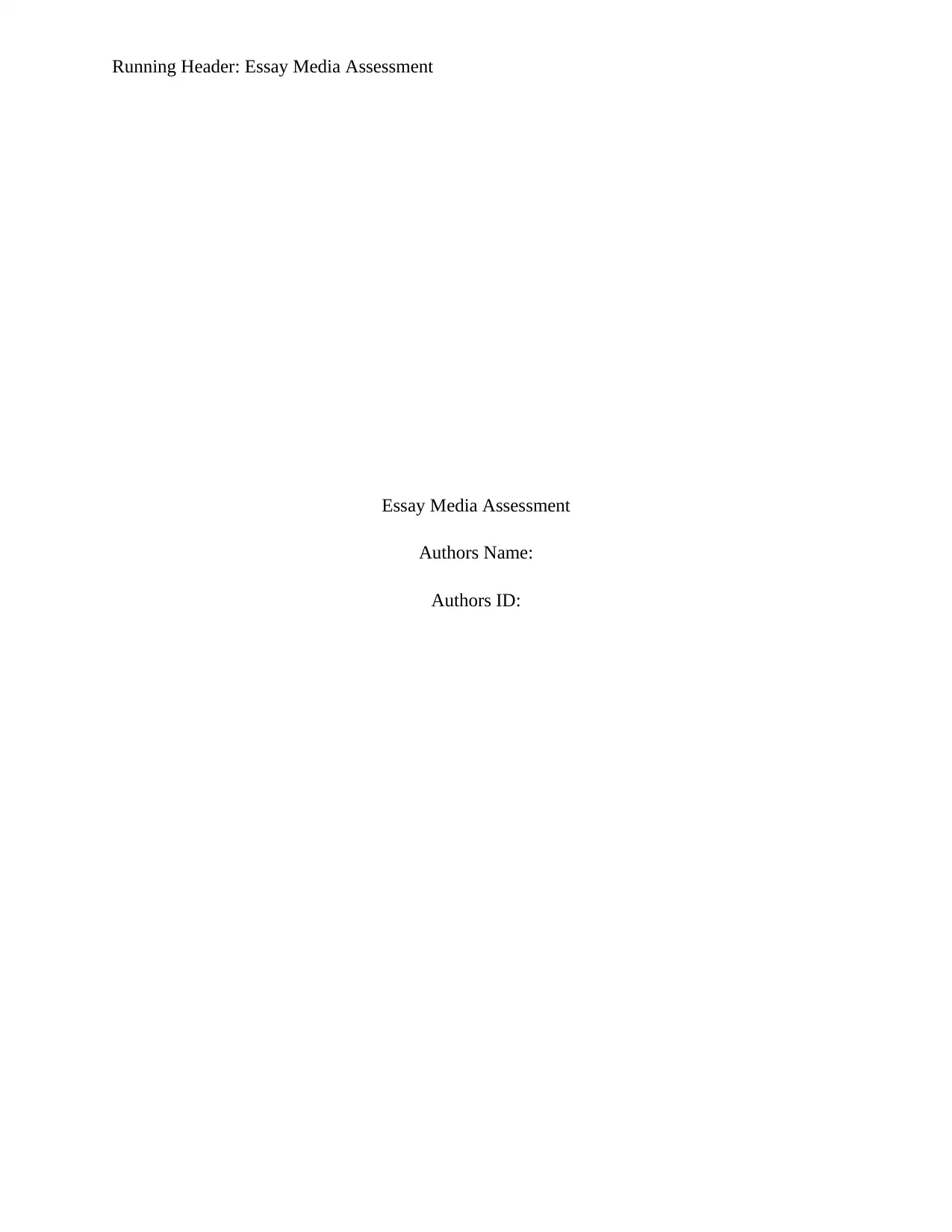
Running Header: Essay Media Assessment
Essay Media Assessment
Authors Name:
Authors ID:
Essay Media Assessment
Authors Name:
Authors ID:
Paraphrase This Document
Need a fresh take? Get an instant paraphrase of this document with our AI Paraphraser
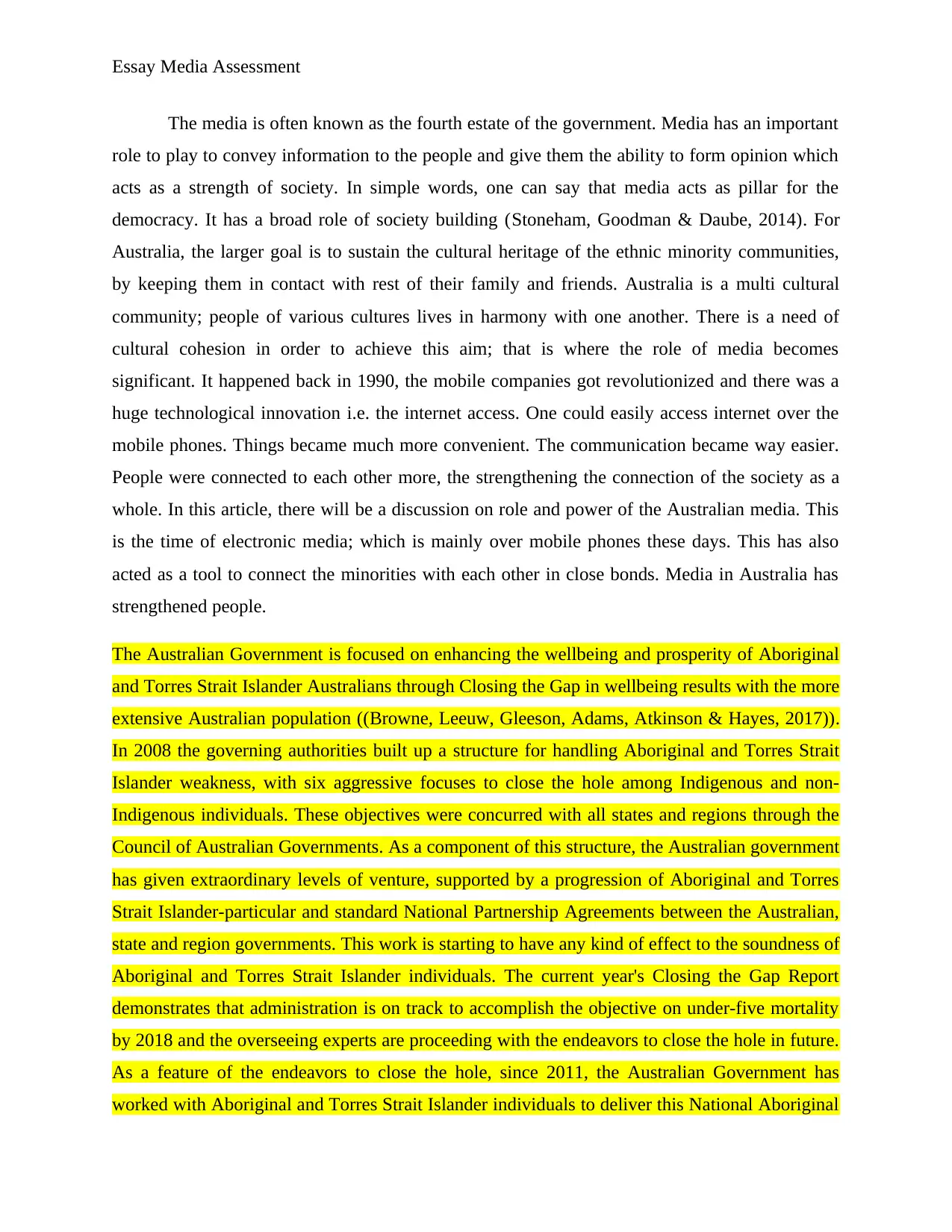
Essay Media Assessment
The media is often known as the fourth estate of the government. Media has an important
role to play to convey information to the people and give them the ability to form opinion which
acts as a strength of society. In simple words, one can say that media acts as pillar for the
democracy. It has a broad role of society building (Stoneham, Goodman & Daube, 2014). For
Australia, the larger goal is to sustain the cultural heritage of the ethnic minority communities,
by keeping them in contact with rest of their family and friends. Australia is a multi cultural
community; people of various cultures lives in harmony with one another. There is a need of
cultural cohesion in order to achieve this aim; that is where the role of media becomes
significant. It happened back in 1990, the mobile companies got revolutionized and there was a
huge technological innovation i.e. the internet access. One could easily access internet over the
mobile phones. Things became much more convenient. The communication became way easier.
People were connected to each other more, the strengthening the connection of the society as a
whole. In this article, there will be a discussion on role and power of the Australian media. This
is the time of electronic media; which is mainly over mobile phones these days. This has also
acted as a tool to connect the minorities with each other in close bonds. Media in Australia has
strengthened people.
The Australian Government is focused on enhancing the wellbeing and prosperity of Aboriginal
and Torres Strait Islander Australians through Closing the Gap in wellbeing results with the more
extensive Australian population ((Browne, Leeuw, Gleeson, Adams, Atkinson & Hayes, 2017)).
In 2008 the governing authorities built up a structure for handling Aboriginal and Torres Strait
Islander weakness, with six aggressive focuses to close the hole among Indigenous and non-
Indigenous individuals. These objectives were concurred with all states and regions through the
Council of Australian Governments. As a component of this structure, the Australian government
has given extraordinary levels of venture, supported by a progression of Aboriginal and Torres
Strait Islander-particular and standard National Partnership Agreements between the Australian,
state and region governments. This work is starting to have any kind of effect to the soundness of
Aboriginal and Torres Strait Islander individuals. The current year's Closing the Gap Report
demonstrates that administration is on track to accomplish the objective on under-five mortality
by 2018 and the overseeing experts are proceeding with the endeavors to close the hole in future.
As a feature of the endeavors to close the hole, since 2011, the Australian Government has
worked with Aboriginal and Torres Strait Islander individuals to deliver this National Aboriginal
The media is often known as the fourth estate of the government. Media has an important
role to play to convey information to the people and give them the ability to form opinion which
acts as a strength of society. In simple words, one can say that media acts as pillar for the
democracy. It has a broad role of society building (Stoneham, Goodman & Daube, 2014). For
Australia, the larger goal is to sustain the cultural heritage of the ethnic minority communities,
by keeping them in contact with rest of their family and friends. Australia is a multi cultural
community; people of various cultures lives in harmony with one another. There is a need of
cultural cohesion in order to achieve this aim; that is where the role of media becomes
significant. It happened back in 1990, the mobile companies got revolutionized and there was a
huge technological innovation i.e. the internet access. One could easily access internet over the
mobile phones. Things became much more convenient. The communication became way easier.
People were connected to each other more, the strengthening the connection of the society as a
whole. In this article, there will be a discussion on role and power of the Australian media. This
is the time of electronic media; which is mainly over mobile phones these days. This has also
acted as a tool to connect the minorities with each other in close bonds. Media in Australia has
strengthened people.
The Australian Government is focused on enhancing the wellbeing and prosperity of Aboriginal
and Torres Strait Islander Australians through Closing the Gap in wellbeing results with the more
extensive Australian population ((Browne, Leeuw, Gleeson, Adams, Atkinson & Hayes, 2017)).
In 2008 the governing authorities built up a structure for handling Aboriginal and Torres Strait
Islander weakness, with six aggressive focuses to close the hole among Indigenous and non-
Indigenous individuals. These objectives were concurred with all states and regions through the
Council of Australian Governments. As a component of this structure, the Australian government
has given extraordinary levels of venture, supported by a progression of Aboriginal and Torres
Strait Islander-particular and standard National Partnership Agreements between the Australian,
state and region governments. This work is starting to have any kind of effect to the soundness of
Aboriginal and Torres Strait Islander individuals. The current year's Closing the Gap Report
demonstrates that administration is on track to accomplish the objective on under-five mortality
by 2018 and the overseeing experts are proceeding with the endeavors to close the hole in future.
As a feature of the endeavors to close the hole, since 2011, the Australian Government has
worked with Aboriginal and Torres Strait Islander individuals to deliver this National Aboriginal

Essay Media Assessment
and Torres Strait Islander Health Plan, giving a chance to cooperatively set out a multiyear plan
for the bearing of Indigenous wellbeing strategy (Sibthorpe et al., 2017). This Health Plan
likewise gives an emphasis on the prosperity of Aboriginal and Torres Strait Islander individuals
with an inability, youngsters and for sound maturing. All things considered it expands on the
pledge to new Closing the Gap targets, including the new target went for expanding access to
administrations for Aboriginal and Torres Strait Islander individuals with incapacity.
In democracy media acts as an institution within itself. It mainly aims to serve political and
social purposes. It is way much different than any other form of enterprise. It provides a platform
to people for fair debate. It empowers people; give them analysis of the current scenario and acts
as a necessary tool for them to take political decisions (Wakerman, Humphreys, Wells, Kuipers,
Entwistle & Jones, 2017). This is a collaboration of organizations who works towards public
interest. This is the platform where larger organizations are answerable to people. It acts as a
medium in-between. If there is any issue prevalent within the nation, it is the role of media to
mobilize the support or opposition for it. From the above factors we can easily see that media is
an important part of democracy. Media is essential for democracy in order to serve its true
propose. The media also is a major source of entertainment.
Apart from just spreading information across the globe or providing platform for public debate,
media also keeps an eye on people at high authorities or who are in power, it plays an important
role in monitoring and investigating public issues (Pynta, Seixas, Nield, Hier, Millward &
Silberstein, 2014). Initially this function to investigate was assigned to press, it is the way the
media has formed itself over the course of these years in its history. The press has been restricted
by government from time to time in history; when in its initial days it was called dangerous.
There have been issues from time to time like freedom of expression; there have been enormous
faced over this issue already. There have been political fights over to issue that media should not
be censored or restricted by the government, in spite of which it will fail to, be a liberal
democracy. That is why it is mainly known as the fourth estate of democracy and government.
Australian media has a major strength that is its sector based diversity. It has been divided into
many factors (Little, 2015). Mainly there are these three sectors; public, commercial and
community. Social media has also gained huge popularity in the recent years. It has served major
part in the daily lives of the Australian people in conveying information in a very efficient
and Torres Strait Islander Health Plan, giving a chance to cooperatively set out a multiyear plan
for the bearing of Indigenous wellbeing strategy (Sibthorpe et al., 2017). This Health Plan
likewise gives an emphasis on the prosperity of Aboriginal and Torres Strait Islander individuals
with an inability, youngsters and for sound maturing. All things considered it expands on the
pledge to new Closing the Gap targets, including the new target went for expanding access to
administrations for Aboriginal and Torres Strait Islander individuals with incapacity.
In democracy media acts as an institution within itself. It mainly aims to serve political and
social purposes. It is way much different than any other form of enterprise. It provides a platform
to people for fair debate. It empowers people; give them analysis of the current scenario and acts
as a necessary tool for them to take political decisions (Wakerman, Humphreys, Wells, Kuipers,
Entwistle & Jones, 2017). This is a collaboration of organizations who works towards public
interest. This is the platform where larger organizations are answerable to people. It acts as a
medium in-between. If there is any issue prevalent within the nation, it is the role of media to
mobilize the support or opposition for it. From the above factors we can easily see that media is
an important part of democracy. Media is essential for democracy in order to serve its true
propose. The media also is a major source of entertainment.
Apart from just spreading information across the globe or providing platform for public debate,
media also keeps an eye on people at high authorities or who are in power, it plays an important
role in monitoring and investigating public issues (Pynta, Seixas, Nield, Hier, Millward &
Silberstein, 2014). Initially this function to investigate was assigned to press, it is the way the
media has formed itself over the course of these years in its history. The press has been restricted
by government from time to time in history; when in its initial days it was called dangerous.
There have been issues from time to time like freedom of expression; there have been enormous
faced over this issue already. There have been political fights over to issue that media should not
be censored or restricted by the government, in spite of which it will fail to, be a liberal
democracy. That is why it is mainly known as the fourth estate of democracy and government.
Australian media has a major strength that is its sector based diversity. It has been divided into
many factors (Little, 2015). Mainly there are these three sectors; public, commercial and
community. Social media has also gained huge popularity in the recent years. It has served major
part in the daily lives of the Australian people in conveying information in a very efficient
⊘ This is a preview!⊘
Do you want full access?
Subscribe today to unlock all pages.

Trusted by 1+ million students worldwide
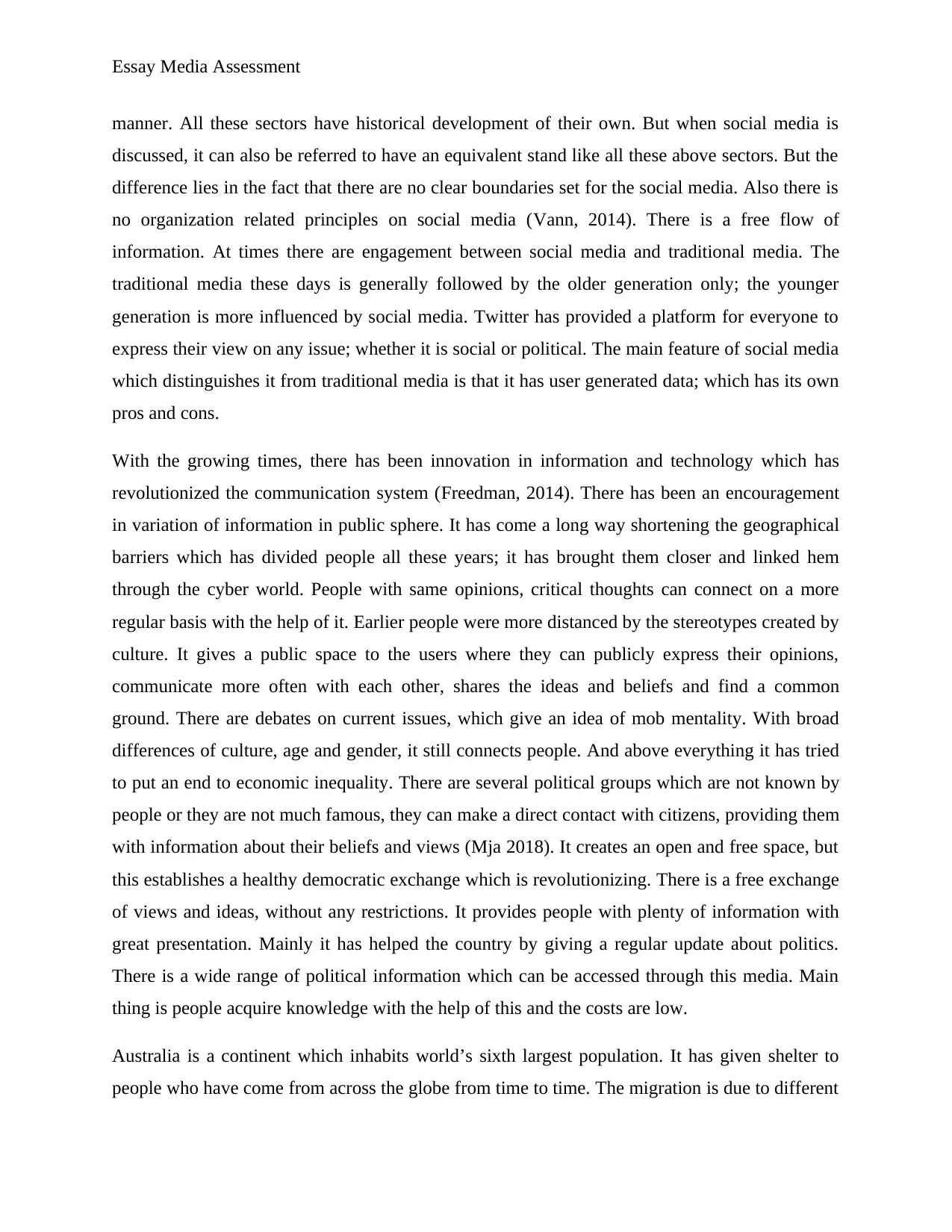
Essay Media Assessment
manner. All these sectors have historical development of their own. But when social media is
discussed, it can also be referred to have an equivalent stand like all these above sectors. But the
difference lies in the fact that there are no clear boundaries set for the social media. Also there is
no organization related principles on social media (Vann, 2014). There is a free flow of
information. At times there are engagement between social media and traditional media. The
traditional media these days is generally followed by the older generation only; the younger
generation is more influenced by social media. Twitter has provided a platform for everyone to
express their view on any issue; whether it is social or political. The main feature of social media
which distinguishes it from traditional media is that it has user generated data; which has its own
pros and cons.
With the growing times, there has been innovation in information and technology which has
revolutionized the communication system (Freedman, 2014). There has been an encouragement
in variation of information in public sphere. It has come a long way shortening the geographical
barriers which has divided people all these years; it has brought them closer and linked hem
through the cyber world. People with same opinions, critical thoughts can connect on a more
regular basis with the help of it. Earlier people were more distanced by the stereotypes created by
culture. It gives a public space to the users where they can publicly express their opinions,
communicate more often with each other, shares the ideas and beliefs and find a common
ground. There are debates on current issues, which give an idea of mob mentality. With broad
differences of culture, age and gender, it still connects people. And above everything it has tried
to put an end to economic inequality. There are several political groups which are not known by
people or they are not much famous, they can make a direct contact with citizens, providing them
with information about their beliefs and views (Mja 2018). It creates an open and free space, but
this establishes a healthy democratic exchange which is revolutionizing. There is a free exchange
of views and ideas, without any restrictions. It provides people with plenty of information with
great presentation. Mainly it has helped the country by giving a regular update about politics.
There is a wide range of political information which can be accessed through this media. Main
thing is people acquire knowledge with the help of this and the costs are low.
Australia is a continent which inhabits world’s sixth largest population. It has given shelter to
people who have come from across the globe from time to time. The migration is due to different
manner. All these sectors have historical development of their own. But when social media is
discussed, it can also be referred to have an equivalent stand like all these above sectors. But the
difference lies in the fact that there are no clear boundaries set for the social media. Also there is
no organization related principles on social media (Vann, 2014). There is a free flow of
information. At times there are engagement between social media and traditional media. The
traditional media these days is generally followed by the older generation only; the younger
generation is more influenced by social media. Twitter has provided a platform for everyone to
express their view on any issue; whether it is social or political. The main feature of social media
which distinguishes it from traditional media is that it has user generated data; which has its own
pros and cons.
With the growing times, there has been innovation in information and technology which has
revolutionized the communication system (Freedman, 2014). There has been an encouragement
in variation of information in public sphere. It has come a long way shortening the geographical
barriers which has divided people all these years; it has brought them closer and linked hem
through the cyber world. People with same opinions, critical thoughts can connect on a more
regular basis with the help of it. Earlier people were more distanced by the stereotypes created by
culture. It gives a public space to the users where they can publicly express their opinions,
communicate more often with each other, shares the ideas and beliefs and find a common
ground. There are debates on current issues, which give an idea of mob mentality. With broad
differences of culture, age and gender, it still connects people. And above everything it has tried
to put an end to economic inequality. There are several political groups which are not known by
people or they are not much famous, they can make a direct contact with citizens, providing them
with information about their beliefs and views (Mja 2018). It creates an open and free space, but
this establishes a healthy democratic exchange which is revolutionizing. There is a free exchange
of views and ideas, without any restrictions. It provides people with plenty of information with
great presentation. Mainly it has helped the country by giving a regular update about politics.
There is a wide range of political information which can be accessed through this media. Main
thing is people acquire knowledge with the help of this and the costs are low.
Australia is a continent which inhabits world’s sixth largest population. It has given shelter to
people who have come from across the globe from time to time. The migration is due to different
Paraphrase This Document
Need a fresh take? Get an instant paraphrase of this document with our AI Paraphraser
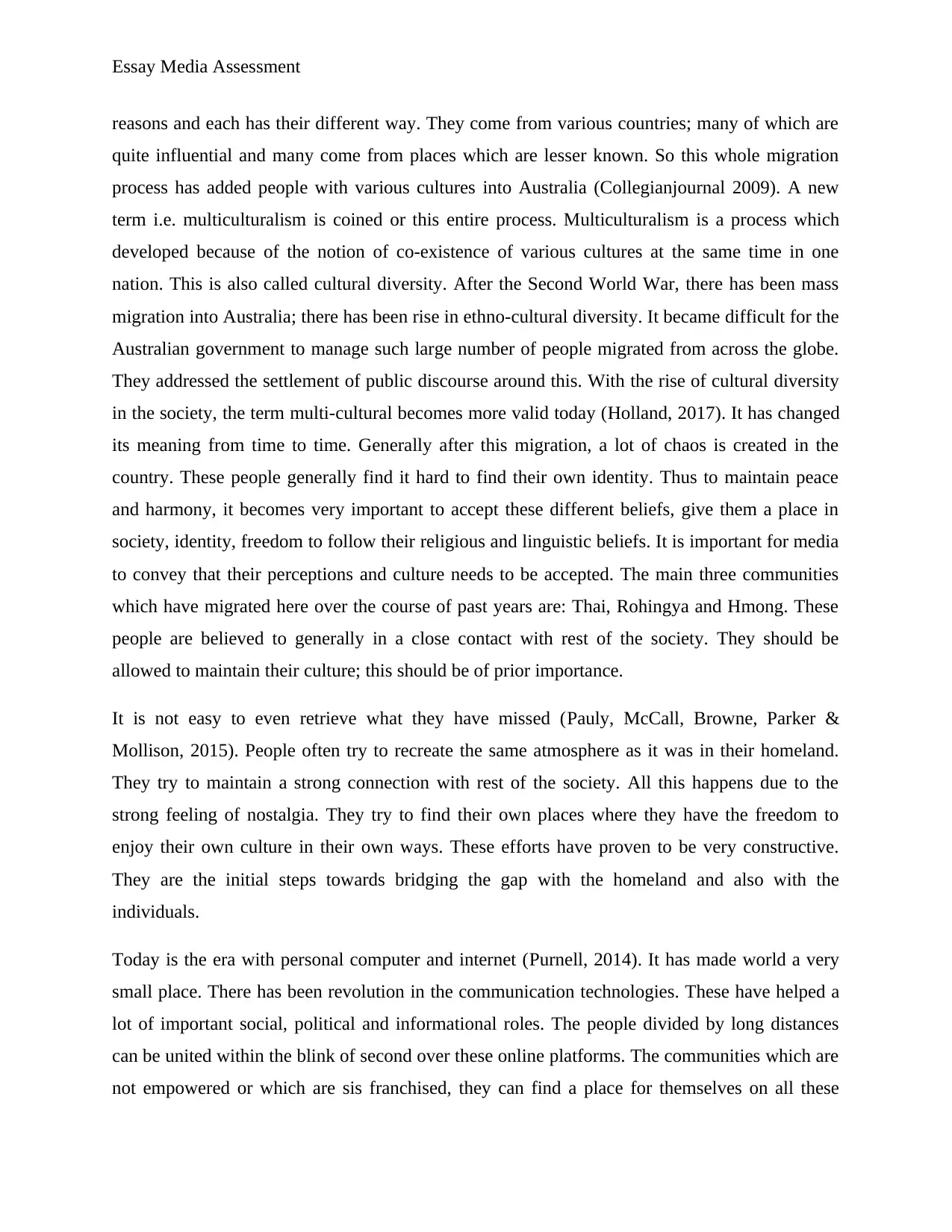
Essay Media Assessment
reasons and each has their different way. They come from various countries; many of which are
quite influential and many come from places which are lesser known. So this whole migration
process has added people with various cultures into Australia (Collegianjournal 2009). A new
term i.e. multiculturalism is coined or this entire process. Multiculturalism is a process which
developed because of the notion of co-existence of various cultures at the same time in one
nation. This is also called cultural diversity. After the Second World War, there has been mass
migration into Australia; there has been rise in ethno-cultural diversity. It became difficult for the
Australian government to manage such large number of people migrated from across the globe.
They addressed the settlement of public discourse around this. With the rise of cultural diversity
in the society, the term multi-cultural becomes more valid today (Holland, 2017). It has changed
its meaning from time to time. Generally after this migration, a lot of chaos is created in the
country. These people generally find it hard to find their own identity. Thus to maintain peace
and harmony, it becomes very important to accept these different beliefs, give them a place in
society, identity, freedom to follow their religious and linguistic beliefs. It is important for media
to convey that their perceptions and culture needs to be accepted. The main three communities
which have migrated here over the course of past years are: Thai, Rohingya and Hmong. These
people are believed to generally in a close contact with rest of the society. They should be
allowed to maintain their culture; this should be of prior importance.
It is not easy to even retrieve what they have missed (Pauly, McCall, Browne, Parker &
Mollison, 2015). People often try to recreate the same atmosphere as it was in their homeland.
They try to maintain a strong connection with rest of the society. All this happens due to the
strong feeling of nostalgia. They try to find their own places where they have the freedom to
enjoy their own culture in their own ways. These efforts have proven to be very constructive.
They are the initial steps towards bridging the gap with the homeland and also with the
individuals.
Today is the era with personal computer and internet (Purnell, 2014). It has made world a very
small place. There has been revolution in the communication technologies. These have helped a
lot of important social, political and informational roles. The people divided by long distances
can be united within the blink of second over these online platforms. The communities which are
not empowered or which are sis franchised, they can find a place for themselves on all these
reasons and each has their different way. They come from various countries; many of which are
quite influential and many come from places which are lesser known. So this whole migration
process has added people with various cultures into Australia (Collegianjournal 2009). A new
term i.e. multiculturalism is coined or this entire process. Multiculturalism is a process which
developed because of the notion of co-existence of various cultures at the same time in one
nation. This is also called cultural diversity. After the Second World War, there has been mass
migration into Australia; there has been rise in ethno-cultural diversity. It became difficult for the
Australian government to manage such large number of people migrated from across the globe.
They addressed the settlement of public discourse around this. With the rise of cultural diversity
in the society, the term multi-cultural becomes more valid today (Holland, 2017). It has changed
its meaning from time to time. Generally after this migration, a lot of chaos is created in the
country. These people generally find it hard to find their own identity. Thus to maintain peace
and harmony, it becomes very important to accept these different beliefs, give them a place in
society, identity, freedom to follow their religious and linguistic beliefs. It is important for media
to convey that their perceptions and culture needs to be accepted. The main three communities
which have migrated here over the course of past years are: Thai, Rohingya and Hmong. These
people are believed to generally in a close contact with rest of the society. They should be
allowed to maintain their culture; this should be of prior importance.
It is not easy to even retrieve what they have missed (Pauly, McCall, Browne, Parker &
Mollison, 2015). People often try to recreate the same atmosphere as it was in their homeland.
They try to maintain a strong connection with rest of the society. All this happens due to the
strong feeling of nostalgia. They try to find their own places where they have the freedom to
enjoy their own culture in their own ways. These efforts have proven to be very constructive.
They are the initial steps towards bridging the gap with the homeland and also with the
individuals.
Today is the era with personal computer and internet (Purnell, 2014). It has made world a very
small place. There has been revolution in the communication technologies. These have helped a
lot of important social, political and informational roles. The people divided by long distances
can be united within the blink of second over these online platforms. The communities which are
not empowered or which are sis franchised, they can find a place for themselves on all these
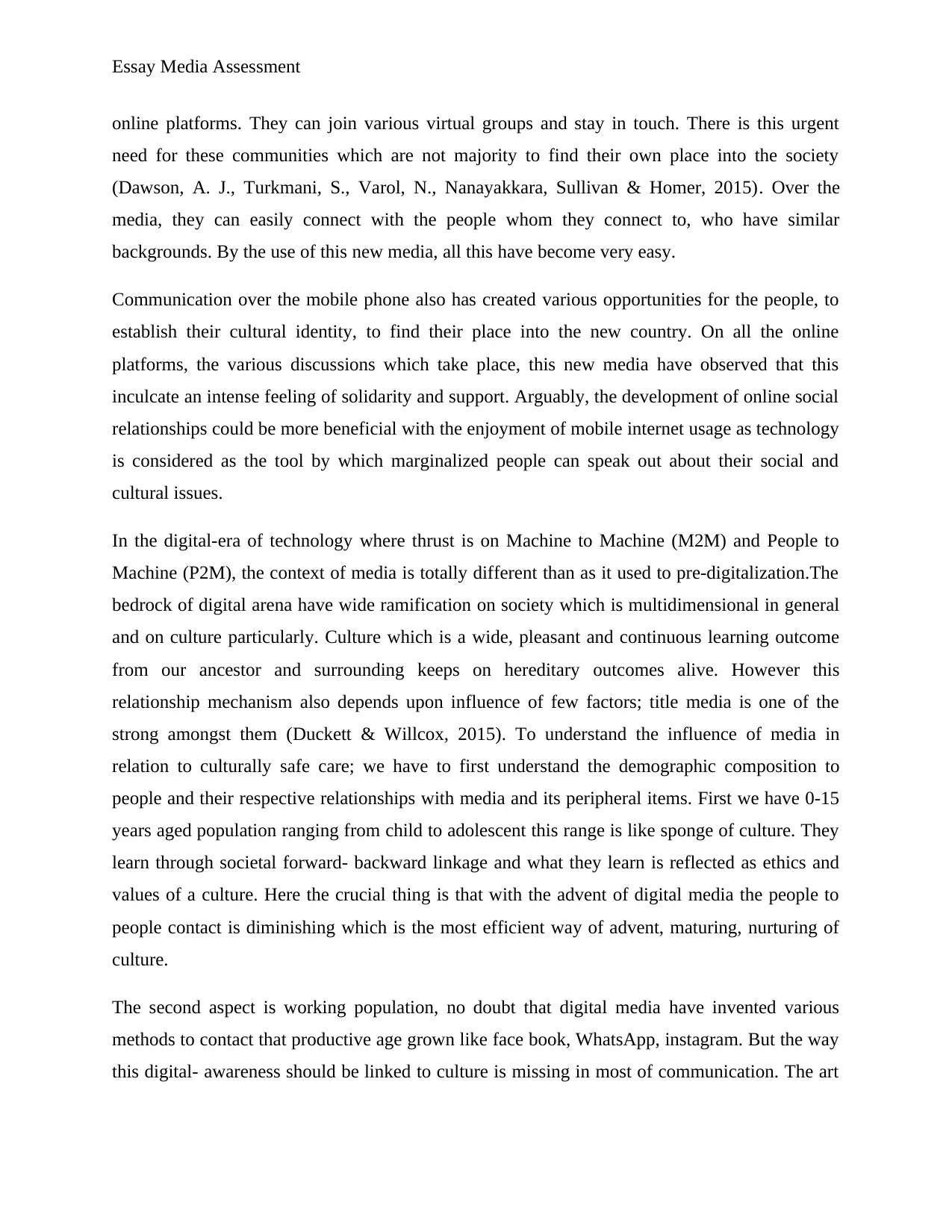
Essay Media Assessment
online platforms. They can join various virtual groups and stay in touch. There is this urgent
need for these communities which are not majority to find their own place into the society
(Dawson, A. J., Turkmani, S., Varol, N., Nanayakkara, Sullivan & Homer, 2015). Over the
media, they can easily connect with the people whom they connect to, who have similar
backgrounds. By the use of this new media, all this have become very easy.
Communication over the mobile phone also has created various opportunities for the people, to
establish their cultural identity, to find their place into the new country. On all the online
platforms, the various discussions which take place, this new media have observed that this
inculcate an intense feeling of solidarity and support. Arguably, the development of online social
relationships could be more beneficial with the enjoyment of mobile internet usage as technology
is considered as the tool by which marginalized people can speak out about their social and
cultural issues.
In the digital-era of technology where thrust is on Machine to Machine (M2M) and People to
Machine (P2M), the context of media is totally different than as it used to pre-digitalization.The
bedrock of digital arena have wide ramification on society which is multidimensional in general
and on culture particularly. Culture which is a wide, pleasant and continuous learning outcome
from our ancestor and surrounding keeps on hereditary outcomes alive. However this
relationship mechanism also depends upon influence of few factors; title media is one of the
strong amongst them (Duckett & Willcox, 2015). To understand the influence of media in
relation to culturally safe care; we have to first understand the demographic composition to
people and their respective relationships with media and its peripheral items. First we have 0-15
years aged population ranging from child to adolescent this range is like sponge of culture. They
learn through societal forward- backward linkage and what they learn is reflected as ethics and
values of a culture. Here the crucial thing is that with the advent of digital media the people to
people contact is diminishing which is the most efficient way of advent, maturing, nurturing of
culture.
The second aspect is working population, no doubt that digital media have invented various
methods to contact that productive age grown like face book, WhatsApp, instagram. But the way
this digital- awareness should be linked to culture is missing in most of communication. The art
online platforms. They can join various virtual groups and stay in touch. There is this urgent
need for these communities which are not majority to find their own place into the society
(Dawson, A. J., Turkmani, S., Varol, N., Nanayakkara, Sullivan & Homer, 2015). Over the
media, they can easily connect with the people whom they connect to, who have similar
backgrounds. By the use of this new media, all this have become very easy.
Communication over the mobile phone also has created various opportunities for the people, to
establish their cultural identity, to find their place into the new country. On all the online
platforms, the various discussions which take place, this new media have observed that this
inculcate an intense feeling of solidarity and support. Arguably, the development of online social
relationships could be more beneficial with the enjoyment of mobile internet usage as technology
is considered as the tool by which marginalized people can speak out about their social and
cultural issues.
In the digital-era of technology where thrust is on Machine to Machine (M2M) and People to
Machine (P2M), the context of media is totally different than as it used to pre-digitalization.The
bedrock of digital arena have wide ramification on society which is multidimensional in general
and on culture particularly. Culture which is a wide, pleasant and continuous learning outcome
from our ancestor and surrounding keeps on hereditary outcomes alive. However this
relationship mechanism also depends upon influence of few factors; title media is one of the
strong amongst them (Duckett & Willcox, 2015). To understand the influence of media in
relation to culturally safe care; we have to first understand the demographic composition to
people and their respective relationships with media and its peripheral items. First we have 0-15
years aged population ranging from child to adolescent this range is like sponge of culture. They
learn through societal forward- backward linkage and what they learn is reflected as ethics and
values of a culture. Here the crucial thing is that with the advent of digital media the people to
people contact is diminishing which is the most efficient way of advent, maturing, nurturing of
culture.
The second aspect is working population, no doubt that digital media have invented various
methods to contact that productive age grown like face book, WhatsApp, instagram. But the way
this digital- awareness should be linked to culture is missing in most of communication. The art
⊘ This is a preview!⊘
Do you want full access?
Subscribe today to unlock all pages.

Trusted by 1+ million students worldwide
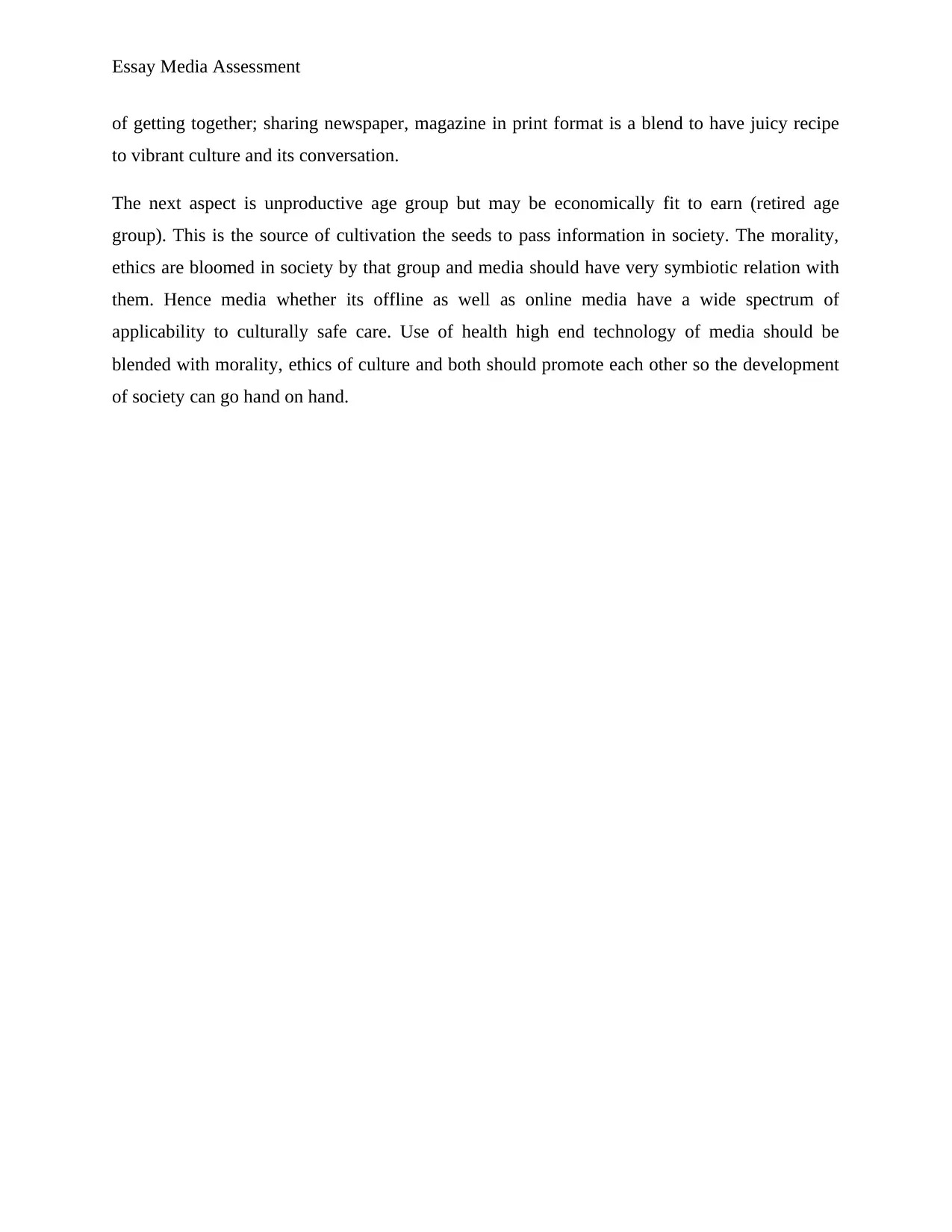
Essay Media Assessment
of getting together; sharing newspaper, magazine in print format is a blend to have juicy recipe
to vibrant culture and its conversation.
The next aspect is unproductive age group but may be economically fit to earn (retired age
group). This is the source of cultivation the seeds to pass information in society. The morality,
ethics are bloomed in society by that group and media should have very symbiotic relation with
them. Hence media whether its offline as well as online media have a wide spectrum of
applicability to culturally safe care. Use of health high end technology of media should be
blended with morality, ethics of culture and both should promote each other so the development
of society can go hand on hand.
of getting together; sharing newspaper, magazine in print format is a blend to have juicy recipe
to vibrant culture and its conversation.
The next aspect is unproductive age group but may be economically fit to earn (retired age
group). This is the source of cultivation the seeds to pass information in society. The morality,
ethics are bloomed in society by that group and media should have very symbiotic relation with
them. Hence media whether its offline as well as online media have a wide spectrum of
applicability to culturally safe care. Use of health high end technology of media should be
blended with morality, ethics of culture and both should promote each other so the development
of society can go hand on hand.
Paraphrase This Document
Need a fresh take? Get an instant paraphrase of this document with our AI Paraphraser
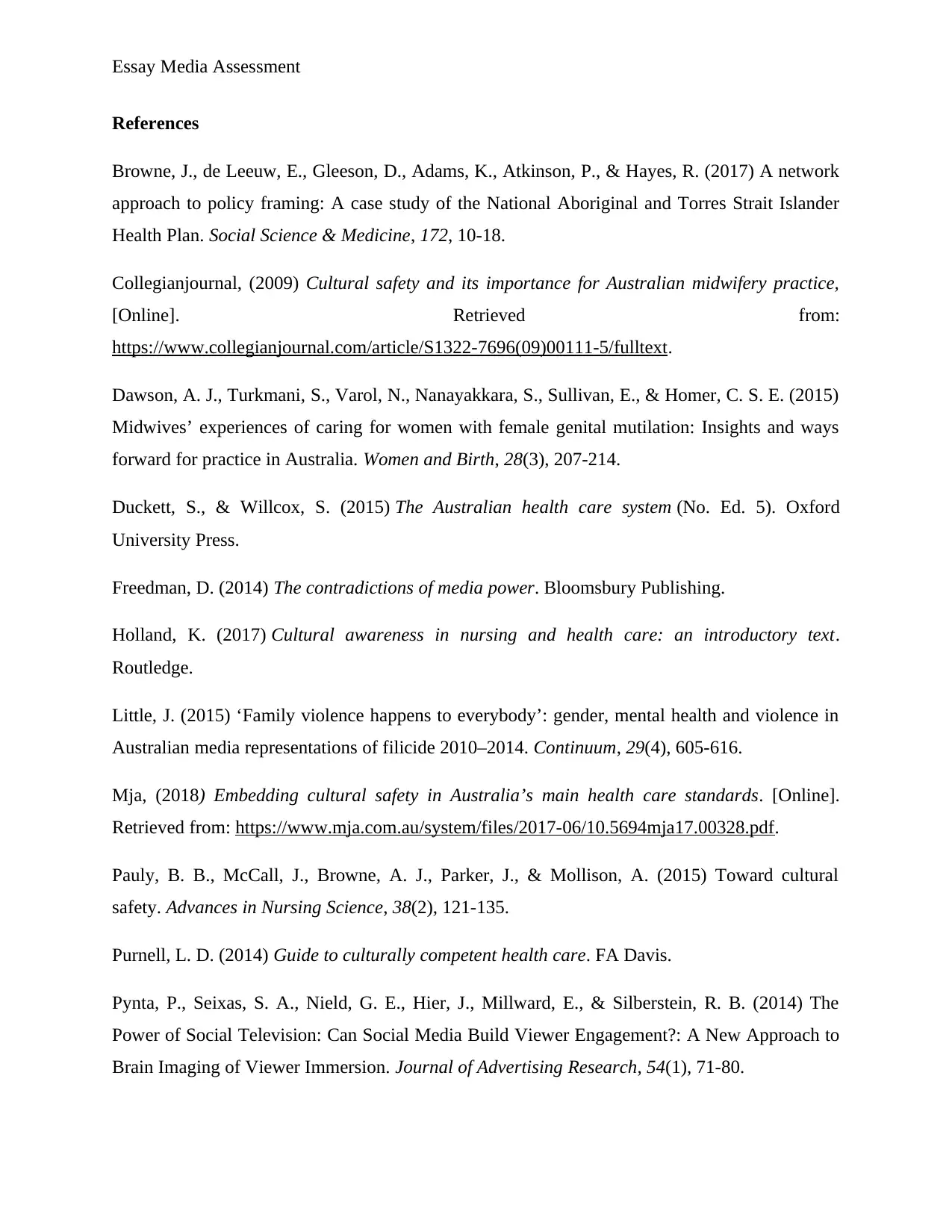
Essay Media Assessment
References
Browne, J., de Leeuw, E., Gleeson, D., Adams, K., Atkinson, P., & Hayes, R. (2017) A network
approach to policy framing: A case study of the National Aboriginal and Torres Strait Islander
Health Plan. Social Science & Medicine, 172, 10-18.
Collegianjournal, (2009) Cultural safety and its importance for Australian midwifery practice,
[Online]. Retrieved from:
https://www.collegianjournal.com/article/S1322-7696(09)00111-5/fulltext.
Dawson, A. J., Turkmani, S., Varol, N., Nanayakkara, S., Sullivan, E., & Homer, C. S. E. (2015)
Midwives’ experiences of caring for women with female genital mutilation: Insights and ways
forward for practice in Australia. Women and Birth, 28(3), 207-214.
Duckett, S., & Willcox, S. (2015) The Australian health care system (No. Ed. 5). Oxford
University Press.
Freedman, D. (2014) The contradictions of media power. Bloomsbury Publishing.
Holland, K. (2017) Cultural awareness in nursing and health care: an introductory text.
Routledge.
Little, J. (2015) ‘Family violence happens to everybody’: gender, mental health and violence in
Australian media representations of filicide 2010–2014. Continuum, 29(4), 605-616.
Mja, (2018) Embedding cultural safety in Australia’s main health care standards. [Online].
Retrieved from: https://www.mja.com.au/system/files/2017-06/10.5694mja17.00328.pdf.
Pauly, B. B., McCall, J., Browne, A. J., Parker, J., & Mollison, A. (2015) Toward cultural
safety. Advances in Nursing Science, 38(2), 121-135.
Purnell, L. D. (2014) Guide to culturally competent health care. FA Davis.
Pynta, P., Seixas, S. A., Nield, G. E., Hier, J., Millward, E., & Silberstein, R. B. (2014) The
Power of Social Television: Can Social Media Build Viewer Engagement?: A New Approach to
Brain Imaging of Viewer Immersion. Journal of Advertising Research, 54(1), 71-80.
References
Browne, J., de Leeuw, E., Gleeson, D., Adams, K., Atkinson, P., & Hayes, R. (2017) A network
approach to policy framing: A case study of the National Aboriginal and Torres Strait Islander
Health Plan. Social Science & Medicine, 172, 10-18.
Collegianjournal, (2009) Cultural safety and its importance for Australian midwifery practice,
[Online]. Retrieved from:
https://www.collegianjournal.com/article/S1322-7696(09)00111-5/fulltext.
Dawson, A. J., Turkmani, S., Varol, N., Nanayakkara, S., Sullivan, E., & Homer, C. S. E. (2015)
Midwives’ experiences of caring for women with female genital mutilation: Insights and ways
forward for practice in Australia. Women and Birth, 28(3), 207-214.
Duckett, S., & Willcox, S. (2015) The Australian health care system (No. Ed. 5). Oxford
University Press.
Freedman, D. (2014) The contradictions of media power. Bloomsbury Publishing.
Holland, K. (2017) Cultural awareness in nursing and health care: an introductory text.
Routledge.
Little, J. (2015) ‘Family violence happens to everybody’: gender, mental health and violence in
Australian media representations of filicide 2010–2014. Continuum, 29(4), 605-616.
Mja, (2018) Embedding cultural safety in Australia’s main health care standards. [Online].
Retrieved from: https://www.mja.com.au/system/files/2017-06/10.5694mja17.00328.pdf.
Pauly, B. B., McCall, J., Browne, A. J., Parker, J., & Mollison, A. (2015) Toward cultural
safety. Advances in Nursing Science, 38(2), 121-135.
Purnell, L. D. (2014) Guide to culturally competent health care. FA Davis.
Pynta, P., Seixas, S. A., Nield, G. E., Hier, J., Millward, E., & Silberstein, R. B. (2014) The
Power of Social Television: Can Social Media Build Viewer Engagement?: A New Approach to
Brain Imaging of Viewer Immersion. Journal of Advertising Research, 54(1), 71-80.
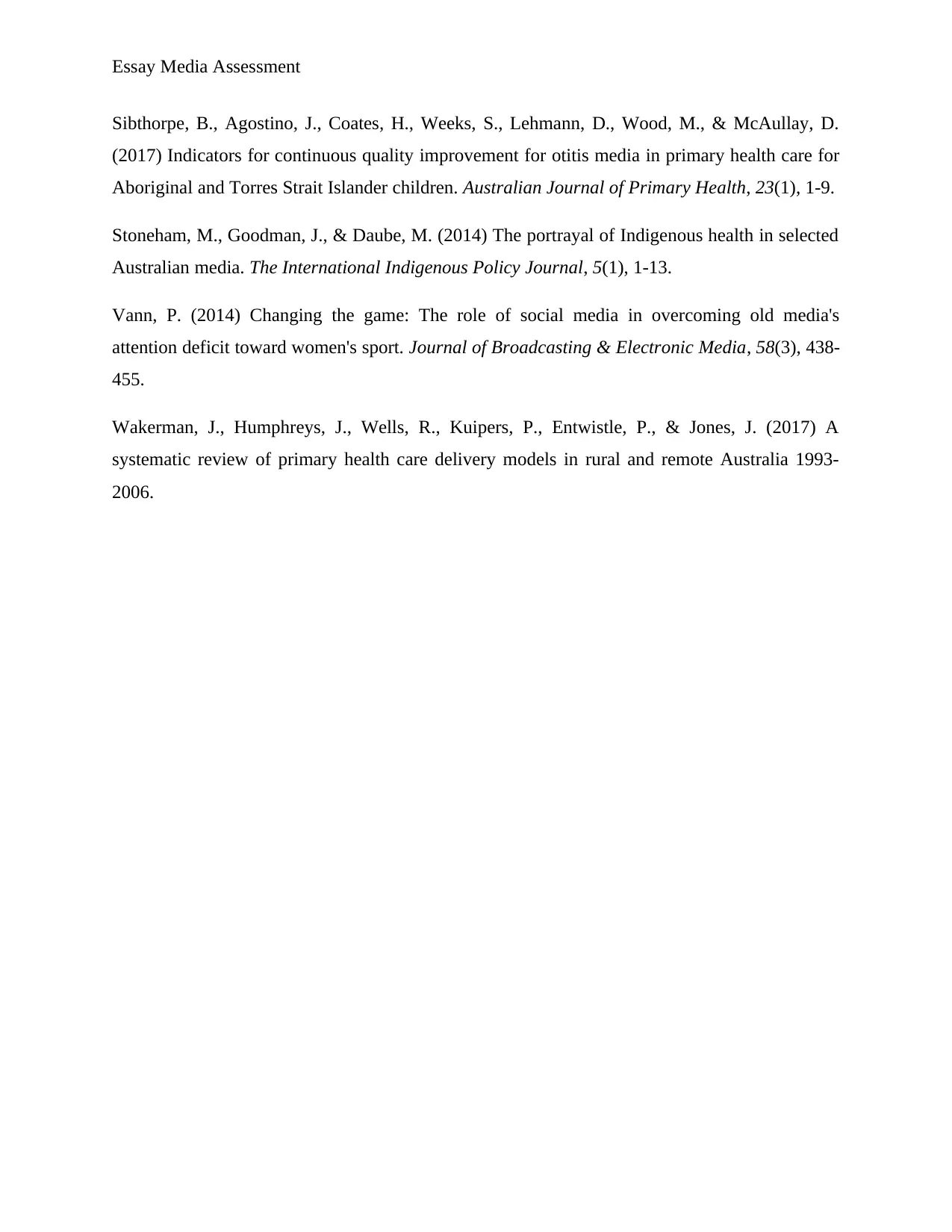
Essay Media Assessment
Sibthorpe, B., Agostino, J., Coates, H., Weeks, S., Lehmann, D., Wood, M., & McAullay, D.
(2017) Indicators for continuous quality improvement for otitis media in primary health care for
Aboriginal and Torres Strait Islander children. Australian Journal of Primary Health, 23(1), 1-9.
Stoneham, M., Goodman, J., & Daube, M. (2014) The portrayal of Indigenous health in selected
Australian media. The International Indigenous Policy Journal, 5(1), 1-13.
Vann, P. (2014) Changing the game: The role of social media in overcoming old media's
attention deficit toward women's sport. Journal of Broadcasting & Electronic Media, 58(3), 438-
455.
Wakerman, J., Humphreys, J., Wells, R., Kuipers, P., Entwistle, P., & Jones, J. (2017) A
systematic review of primary health care delivery models in rural and remote Australia 1993-
2006.
Sibthorpe, B., Agostino, J., Coates, H., Weeks, S., Lehmann, D., Wood, M., & McAullay, D.
(2017) Indicators for continuous quality improvement for otitis media in primary health care for
Aboriginal and Torres Strait Islander children. Australian Journal of Primary Health, 23(1), 1-9.
Stoneham, M., Goodman, J., & Daube, M. (2014) The portrayal of Indigenous health in selected
Australian media. The International Indigenous Policy Journal, 5(1), 1-13.
Vann, P. (2014) Changing the game: The role of social media in overcoming old media's
attention deficit toward women's sport. Journal of Broadcasting & Electronic Media, 58(3), 438-
455.
Wakerman, J., Humphreys, J., Wells, R., Kuipers, P., Entwistle, P., & Jones, J. (2017) A
systematic review of primary health care delivery models in rural and remote Australia 1993-
2006.
⊘ This is a preview!⊘
Do you want full access?
Subscribe today to unlock all pages.

Trusted by 1+ million students worldwide
1 out of 9
Related Documents
Your All-in-One AI-Powered Toolkit for Academic Success.
+13062052269
info@desklib.com
Available 24*7 on WhatsApp / Email
![[object Object]](/_next/static/media/star-bottom.7253800d.svg)
Unlock your academic potential
Copyright © 2020–2025 A2Z Services. All Rights Reserved. Developed and managed by ZUCOL.





